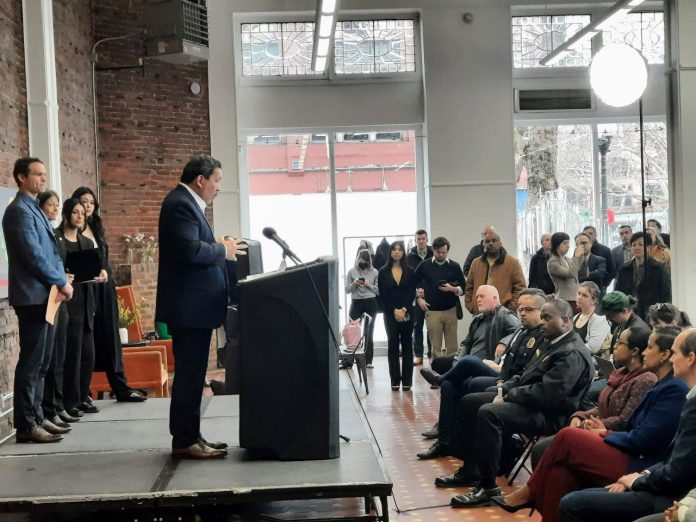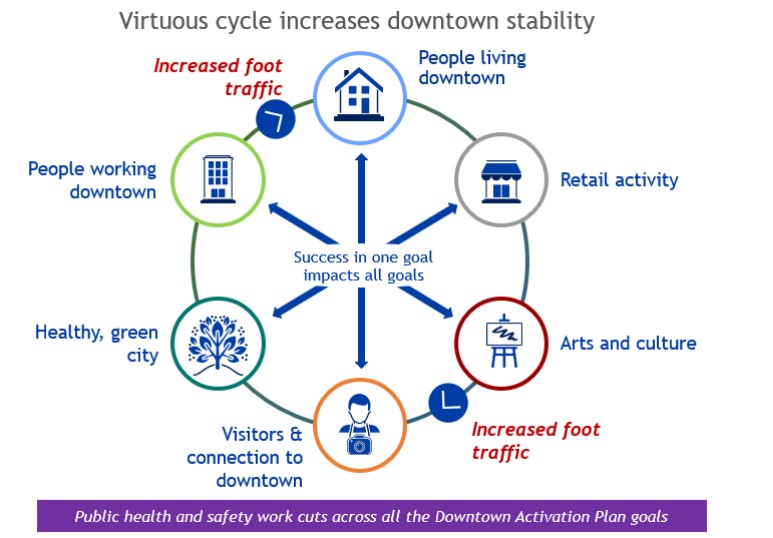This summer, Seattleites could be playing pickleball and giant chess in downtown streets rather than dodging oncoming traffic and hustling past boarded up storefronts. Mayor Bruce Harrell sees it as a possibility, unveiling a new initiative aimed at revitalizing downtown yesterday from a Pioneer Square gallery space filled with media and leaders from his administration and business organizations.
On one hand, the Downtown Activation Plan aims to crack down on fentanyl distribution, funnel more people into drug treatment, and increase emphasis patrols and cleaning crews. On the other, the plan proposes pedestrian-friendly street festivals, filling vacant storefronts, and attracting more childcare centers and schools downtown with the hope of encouraging more activity and drawing more residents to the core of the city.
It remains to be seen whether the plan can inspire a downtown focused urban “renaissance” to roar back from pandemic doldrums that some speakers evoked. The full DAP plan with the legislative package is promised in June.
Seattle’s history is rife with mayors announcing new waves of emphasis patrols at crime hotspots and crackdowns on drug traffickers. History suggests those crime hotspots re-emerge and drug distribution networks reestablish themselves. The Harrell administration is hoping this wave of enforcement can provide a more durable solution, and they are pairing it with some harm reduction strategies that aim to reduce drug overdose deaths and encourage drug users to seek treatment. King County’s overdose fatalities spiked to 525 last year.
The fentanyl crackdown was at the request of the business community. In March, the Seattle Metropolitan Chamber of Commerce and Downtown Seattle Association (DSA) partnered on their own version of a downtown activation plan that included a recommendation for an executive order to go after fentanyl distributors. Another Chamber/DSA recommendation that the Mayor has not yet embraced is a tax break for the city’s largest employers, declaring a holiday on the JumpStart corporate payroll tax in hopes of spurring hiring. With City budget forecasts suggesting another shortfall, such a recommendation would blow a huge hole in the budget.
Harrell’s executive order on fentanyl directs the City to “[p]ilot a research-based drug abatement program known as ‘contingency management,’ an effort designed to encourage individuals with substance use disorder to accept treatment services by providing incentives (usually gift cards). The 12-week program rewards drug users for abstinence and, in a unique manner, is administered where people live instead of a medical clinic.” Harrell said details and funding for the new drug treatment programs was still being hashed out. Councilmember Sara Nelson said the half-billion-dollar state opiate distributor settlement could provide one source of funding.
One harm reduction strategy that Harrell did not embrace is safe drug consumption sites, saying he needed to see more evidence and a city where it “actually worked.”
The Mayor and his director of the Office of Economic Development, Markham McIntyre, also spoke of using land use policy to increase business activity and residential growth in the greater downtown core. The perpetually anticipated industrial land use policy update recently moved to a legislative phase and proposes to add 3,000 homes in today’s industrial zones, many of them in the SoDo area with increased commercial activity in an expanded stadium district. The DAP also hints at a plan to create zoning incentives for mixed-use developments that add childcare and school facilities downtown.
Councilmember Andrew Lewis, who was in attendance at the event sitting in the first row, said he has been working on the incentive program and excited to partner with Harrell on it. Lewis said he envisions the Third Avenue corridor as a great target for the program since it has low-slung land parcels and a restrictive zoning policy capped awkwardly at 12 stories that could make height incentives very enticing to builders, who prefer taller buildings to justify the cost of tower construction.
Assuming those incentives are well-calibrated, Downtown Seattle could finally secure the elementary school that has long been a goal for policymakers, but long eluded the city and been a lament for parents living in the core of the city. But it could take some time and direct intervention from local leaders to ensure the long-awaited school finally takes root.
In the DAP, Harrell announced the following short-term actions:
- “Fill up to 20 vacant storefronts by early summer through the Seattle Restored program, a special city government effort to help small businesses, entrepreneurs, and local artists.”
- “Reopen City Hall Park on June 15, 2023, with new programming, safety, and lighting enhancements, 24/7 security every day of the week, and activities designed to draw people to the park, including movie days, jumbo chess board, concerts, food trucks, and more.”
- “Increase the number of Metropolitan Improvement District ambassadors who help keep downtown streets clean, safe, and welcoming for everyone. Additionally, earlier this month, Mayor Harrell proposed legislation granting a 10-year renewal of the MID with expanded service boundaries to include part of the stadium area south of Pioneer Square.”
- “Encourage more frequent closings of downtown streets for special events, such as onstreet Pickleball competitions, the First Thursday Art Walks in Pioneer Square, street festivals and music concerts.”
- “Increase opportunities for food truck operators and pop-up food vendors to establish a presence downtown by waiving street-use permit fees.”
- “Request the Washington State Liquor and Cannabis Board issue ‘Sip ‘n Stroll’ permits for First Thursday Art Walks so patrons can carry a beverage as they walk from gallery to gallery.”
- “Improve street and sidewalk lighting in areas of downtown where crime and disorder is concentrated.”
- “Increase trash and litter removal and expand graffiti abatement with a focus on the Chinatown-International District.”
- “Update land use policies to create upwards of 30,000 jobs and more housing units in neighborhoods adjacent to downtown and activating the stadium area south of Pioneer Square by allowing more hotels, restaurants, bars, and entertainment centers.”
- “Explore the potential for repurposing downtown office buildings to housing and other uses, including through a competition hosted by the Office of Planning and Community Development.”
Food truck and street vendor liberalization already passed the City Council via a pilot program sponsored by Councilmember Dan Strauss. Likewise, Harrell advanced graffiti abatement through a program funded in the last budget. Harrell teased the office conversion idea during his State of the City speech in February. Industrial land use reform package has been in the works since Mayor Ed Murray’s tenure, but Harrell has the package seemingly at the finish line, finally.
Mayor Harrell fielded a wide gambit of questions that sought to draw out some specifics from a plan of mostly generalities. Right-wing commentators pressed him on whether a harm-reduction approach to drug policy amounted to permissiveness and surrender on the issue. Meanwhile, journalists coming at the issue from a more progressive critical lens wondered if the drug treatment plan added up and if low-level users would get swept up and criminalized in the crackdown on fentanyl distributors, since some users deal small amounts to fund their habit.
Mayor Harrell said the goal would be to target major distributors rather than small timers. However, when pressed, Police Chief Adrian Diaz declined to define what amount would draw the distinction between small and large-scale dealers.
Doug Trumm is publisher of The Urbanist. An Urbanist writer since 2015, he dreams of pedestrian streets, bus lanes, and a mass-timber building spree to end our housing crisis. He graduated from the Evans School of Public Policy and Governance at the University of Washington in 2019. He lives in Seattle's Fremont neighborhood and loves to explore the city by foot and by bike.




